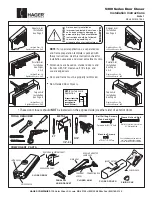
20
installation
&
operation
manual
|
dlv
heating
system
5.3
RECOMMENDED MAINTENANCE
INTERVAL
MAINTENANCE TASK
At initial start-up
Tighten electrical connections.
See
SECOIO 4
.
One week after initial start-up
Check and tighten electrical connections.
See
SECOIO 5.2.2
.
Every three months
Tighten electrical connections.
Annually
Drain, clean and flush heating system.
Check for cracked or weakened hoses and
replace if necessary.
Check electrical wiring and connections for wear
and excessive heat.
Check mounting bolts and tighten if necessary.
Remove element and clean element and tank.
See
SECOIO 5.2.12
.
Every five years
Replace magnetic contactors.
See
SECOIO 5.2.4
.
5.4
STORAGE REQUIREMENTS
If long-term storage is necessary, precautions must be taken to ensure that the heating system is
operational for start-up. If possible, store the system in its original packaging. If storing the heating system
in the original packaging is not possible, steps must be taken to ensure that water ingress is mitigated at all
locations. All plugs and caps must remain tight and a suitable cover must be provided for the system. The
cover must shield the system from direct rain and protect from any directed spray that may occur.
For any storage longer than three months, desiccant bags must be placed next to the system if it is still in
the original packaging and inside the control box. If the storage duration will be one year or longer, the
volatile corrosion inhibitor inside the control box must be replaced at six month intervals.
New pump motors placed in long-term storage for a year or longer may require relubrication before
initial use. If your pump motor has provisions for relubrication, refer to the pump motor manufacturer’s
relubrication recommendations. Refer to the pump motor nameplate for lubrication type.
During the offseason, or during periods in which the heating system is not active for a month or longer,
HOTSTART recommends running the heating system for a minimum of 20 minutes each month. Circulating
and heating fluid at regular intervals will reduce pump seal wear and promote pump seal longevity.


































